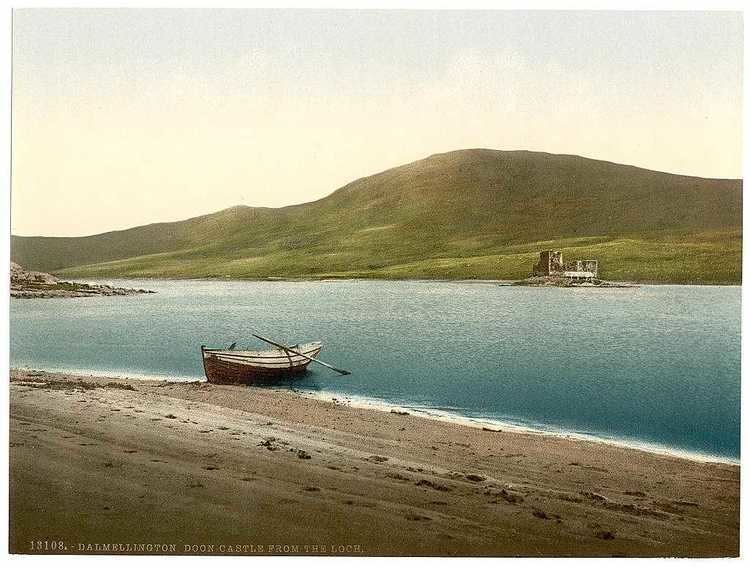OS grid reference NS4764805958 Sovereign state United Kingdom Postcode district KA6 Local time Thursday 4:58 AM | Post town AYR Dialling code 01292 | |
 | ||
Weather 7°C, Wind W at 29 km/h, 91% Humidity Scottish parliament | ||
The norman castle motte at dalmellington east ayrshire
Dalmellington (Scots: Dawmellinton, Scottish Gaelic: Dail M'Fhaolain) is a market town and civil parish in Ayrshire, Scotland. In 2001 the village had a population of 1407. The town owes its origins to the fault line separating the Southern Uplands of Scotland from the Central Lowlands. Dalmellington sits at the issue of a river from the uplands into Dalmellington Moss plain.
Contents
- The norman castle motte at dalmellington east ayrshire
- Map of Dalmellington Ayr UK
- History
- Dalmellington Band
- Craigmark Burntonians F C
- References
Map of Dalmellington, Ayr, UK
The town has a history as a rest area, market town, weaving centre and mining village. The Chalmeston open cast coal mine to the north of the village covered some 742 hectares, but the operations have now ceased and the first phase of the site restoration has been completed.
Robert Hetrick the blacksmith-poet lived in the town in the 19th century. The town has a working museum to record the history of the area.
There are many Sites of Special Scientific Interest around Dalmellington, the most notable being the nearby Loch Doon. Selection of local views The Scottish Dark Sky Observatory is located near Dalmellington and is within the northern edge of the Galloway Forest Dark Sky Park.
Dalmellington Craigengillan Curling Club is the oldest constituted club in Dalmellington; it was formed on December 3, 1841 in the Black Bull Hotel and has continued unbroken since. In 2004 the members reinstated the outside curling pond at Craigengillan, this is the only self leveling curling pond in Scotland.
History
Dalmellington is an ancient settlement of indeterminate origin. It is probable that the area was first occupied some 6,000 years ago, when Man moved inland from the West Coast along the rivers. It was certainly occupied by the Neolithic Period, as cairns and a few scraps of tools from this period have been found. In recent years traces of early human activity have been found around Loch Doon. There may have been crannogs at Bogton Loch and Loch Doon.In the medieval period Dalmellington was part of Kyle Stewart and under the rule of a series of Norman lords, invited to Scotland by the king to assist in subduing the country. On behalf of the king they collected taxes and administered justice. It was during this period that "The Dalmellington Motte" was constructed.
Events from the past have underlined Dalmellington's geographical importance, it is believed that the Doon Valley was a Roman thoroughfare and even possibly a Roman military station. During the time of the Covenanters 900 soldiers were stationed in the vicinity. There were two castles in the area, Loch Doon and Laight Alpin.
Eighteenth century Dalmellington was a small rural village with some 500 inhabitants, but the modern way of life was already taking shape. Good quality coal was being produced from surface workings and sent down the turnpike road to Galloway. The town grew after Watt`s engine had made deeper mine workings feasible, and the completion of the railway in 1858.
Apart from the coal mining, there were 8,000 sheep and 800 black cattle on the hills, and plans were afoot for the spinning and weaving of wool. These plans resulted in two woollen mills which flourished for a time in the following century. The two mills employed about 30 people between them. The yarn from the largest was disposed of wholly to the Kilmarnock carpet manufacturers until the proprietor of the mill added a carpet manufactory with eight looms constantly at work. The yarn spun in the second mill was also manufactured on the spot, into blankets, into plaid, packing cloth, etc.
There were also about 40 weavers working from home. Although by the 20th Century mining was the dominant industry, workers had to travel to outlying areas. Eight pits producing around 124,000 tons a year were operating in the 1940s. With the decline of the labour-intensive deep mining, the area is now dependent on its replacement - opencast (capital intensive) mining.
Dalmellington Band
Dalmellington Band is based in the village of Dalmellington and it is one of Scotland's oldest Brass Bands and has been in the forefront of the movement since its formation in 1864. The band have had notable success in contests and have their name inscribed on every major competition trophy in Scotland, including three Scottish Championship wins. The band regularly provide music for: concerts, gala days, weddings, church services, opening days, parades, background music and Christmas events. In 2014, the band will celebrate its 150th year.
The band is headed by Band President and Musical Director Archie Hutchison.
Craigmark Burntonians F. C.
Craigmark Burntonians F.C. are the local junior football club. They were founded in 1946 and play home games at Station Park on Ayr Road in Dalmellington.
